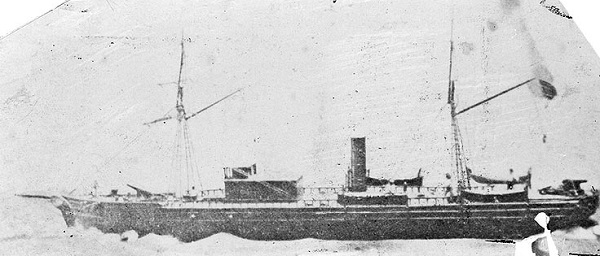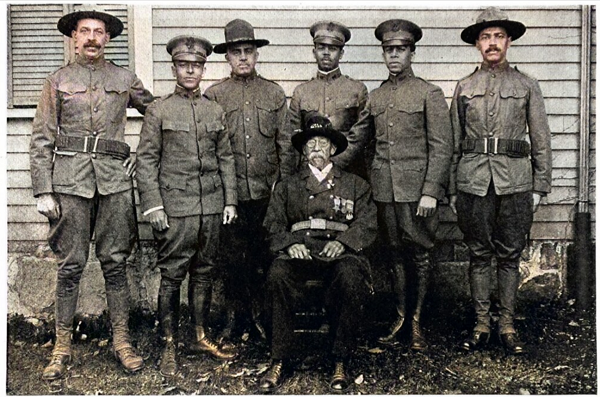William B. Gould, Escaped Slave and Civil War Diarist

William B. Gould III, was up in the attic with his son, clearing old items, dusting and making room. When lifting a box, something fell to the floor. It was his grandfather’s diary. Inside the diary was a story of his grandfather that the world would soon know about.
supporting links
1. William Gould [Wikipedia]
2. Whipped Peter [History]
3. N.C. Highway Historical Marker Recognizes William Gould [NCDRC.Gov]
4. William Benjamin Gould’s diary traces road to freedom [The Bay State Banner]…has picture of sons
5. William B. Gould IV / Stanford professor [SFGate]
6. William B. Gould IV Bio [Stanford Law School]
7. African American Sailors in the U.S. Navy, A Chronology [Naval History & Heritage Command]
8. Diary Passage Transcribed [Massachusetts Historical Society]
9. Stanford Professor Finds Inspiration [Stanford News]
10. William B. Gould statue [Gould Memorial]
Podcast Intro music
1. Courtesy of Fesliyan Studios
Hi, I’m Rick Barron, your host, and welcome to That’s Life, I Swear
It was a warm summer day. A father and his son were up in the attic, clearing out old items, dusting and making room. When lifting a box, a small book fell to the floor. As the father picked it up, he was astonished at what he had discovered. It was his grandfather’s diary. Inside the diary was the story of his grandfathers early and later life. There are those stories, memories, where we hear about something special about a family member no longer with us, something unexpected. This is one of them.
Let’s jump into this.
Will B. Gould III. Courtesy of: QCWA Org
The year was 1958 and William B. Gould III and his son, William B. Gould IV, were addressing the daily chores of keeping a house running. While working in the attic one day, William, the father stumbled upon a diary from his grandfather, that had been sitting in a box for many years.
William Gould IV. Courtesy of: Cornell Chronicle
Gould’s son, that would be the great-grandson, William B. Gould IV, who was helping in the attic that day, became fascinated with his ancestor’s diary. As he turned the pages, he was so transfixed with what had been discover. William, the 4th, took it about himself to spend the next 45 years transcribing and annotating the diary entries, during his spare time while becoming a prominent legal scholar at Stanford University.
Diary of a Contraband by William B. Gould IV. Courtesy of: Amazon
In 2003 Professor Gould completed his work on his great-grandfather’s diary, by publishing it into a book titled, “Diary of a Contraband: The Civil War Passage of a Black Sailor”.
William B. Gould's diary. Courtesy of: New York Times
The diary is one of only a few written during the Civil War by a formerly enslaved person that survived, and the only by a formerly enslaved sailor.
The book reveals the remarkable Civil War diary of the author’s great-grandfather, William Benjamin Gould, an escaped slave who served in the United States Navy from1862 until the end of the war.
William Benjamin Gould, kept copious notes covering his days spent as part of the North Atlantic Blockading Squadron off the coast of North Carolina and Virginia; his travels to New York and Boston. He later served on the USS Niagara while servicing in European waters pursuing Confederate ships such as the Alabama, Florida, and Georgia.
But I’m getting ahead of the story. Let’s cover how this diary came into being.
William Benjamin Gould was born on Nov. 18, 1837, in Wilmington, North Carolina. His parents worked for a white peanut farmer named Nicholas Nixon.
William’s father, Alexander Gould, was a white Englishman; his mother, Elizabeth Moore, was an enslaved Black woman. There were no details in the diary about how they met nor their relationship.
During Williams time on the peanut farm, he came across white missionaries, who were known to provide enslaved people with a basic education, much to the dislike of slave owners.
With the missionaries help, William picked skills in reading and writing.
William picked up other talents on the farm such as masonry. He seemed to be a natural and Mr. Nixon soon put him to work on various construction and renovation projects around the Wilmington area. A building he worked on applying plaster molding, was named the Bellamy Mansion, which today is a museum. The building still bears his initials in the brick work.
When the Civil War broke out, the U.S. Navy, by order of President Lincoln, established a naval blockade in April of 1861, off the Virgina coast to Texas, in order cut off trade and military supplies.
Seeing the blockade from a different light, Nixon, like other wealthy white people, moved his household and slaves inland, in case of an invasion from troops on board the U.S. naval ships.
With all of this confusion and unrest happening, it gave Gould pause to think that this would be an opportunity to plan his escape. He knew his timing had to be right least take the chance of being captured and make matters worse for him.
After waiting almost, a year and a half, Gould planned his escape on September 21, 1862.
Gould wasn’t alone as seven other slaves made the escape with him. Under the cover of darkness and pouring rain, they were able to steal a small sail boat, which they rolled down the Cape Fear River. They rowed instead of hoisting the sail and avoid the risk of being seen.
Gould and the others eventually made it down to Fort Caswell. With the blockade in place, they raised the sail to make it out to one of the Union vessels, the USS Cambridge.
USS Cambridge. Courtesy of: Wikipedia
As fate would turn out, the USS Cambridge had only 18 sailors, thus they were undermanned. Gould and his fellow slaves soon found themselves a part of the United States Navy crew.
On September 27, 1862, William B. Gould, a twenty-four-year-old former slave from Wilmington, North Carolina, began a diary of his service aboard the USS Cambridge, a Union gunboat then patrolling off the Confederate coast.
Over the next three years, Gould spent many a day writing about his journeys during his Civil War service in the U.S. Navy, first aboard the USS Cambridge, and later aboard the USS Niagara.
USS Niagara. Courtesy of Wikipedia
William’s diary is a day-to-day account in his own words of the Civil War service of an African American sailor. As a former slave he served in the United States Navy before Abraham Lincoln signed the Emancipation Proclamation on January 1, 1863.
Gould writing brings out an individual who’s thoughtful, an articulate observer, not only of his surroundings, his life at sea in the Civil War navy, but also the ports and countries that he visited in the course of his service, and of military and political affairs in the United States, and the impact on the lives of African Americans.
Throughout the course of his travels, he related the events of a world being turned upside down by war and emancipation.
Found in the diary, was a passage about his visit to New York City and visiting the offices of The Anglo-African, one of the country’s leading Black newspapers. While in New York, he had the opportunity to listened to a lecture by George Thompson of England, one of Britain’s leading abolitionists.
Gould and his ship were docked in Cadiz, Spain, when news arrived that the Confederates had surrendered at Appomattox, Virginia. The USS Niagara returned to Massachusetts, where he received an honorable discharge from the Navy.
Early photo of William B. William family. Courtesy of: Wikipedia
Upon his discharge, Gould traveled back to Wilmington, which he found it eerily empty. He moved on to Nantucket, Massachusetts, where he married Cornelia Williams Read, who had also been enslaved. They eventually settled in Dedham, Massachusetts, and had eight children, six of whom served in the Army.
William B. Gould with his six sons. Courtesy of: Flickr
After settling in Dedham, Gould put his masonry and plasterer skills back to work and became a very prosperous contractor. He took pride in his work. One time he noticed that a few of his employees had laid cement incorrectly.
The mistake would never be noticed, but Gould knew it. He had the work torn down and redone, a costly decision that almost bankrupted his business but, as word about it spread, it won him significant esteem around town.
Gould died on May 25, 1923, at the age of 85. His descendants knew of his time in the Navy during the Civil War, but it wasn’t until after years of research that William B. Gould IV completed, that it was brought to light that Gould had been born into slavery and had escaped from it.
In September 2021, the town of Dedham renamed a 1.3-acre plot of grass, the William B. Gould Park. On May 25, 2023, the town will unveil a statue of him commemorating the 100th anniversary of his death.
William B. Gould Memorial Statue. Courtesy of: Gould Memorial
What can we learn from this story? What’s the take away
For William B. Gould, his sense of becoming a free person, after escaping slavery gave inspiration to his great-grandson, William B. Gould IV.
People today, particularly the young, sometimes feel disillusioned, discouraged life doesn’t give them what they think they’re entitled to. Mr. Gould’s diary should stand as example of life will not meet you half ways, and sometime never. There are those moments, when one must stand on their own two feet and make it happen.
One must meet their challenges head on and find solutions on their own. When placed in those situations is when you find out who you are. Life is a test and always will be.
Well, there you go. That’s life, I swear.
For further information regarding the material covered in this episode, I invite you to visit my website that you can find on either Apple Podcasts/iTunes or Google Podcasts, for show notes calling out key pieces of content mentioned, and the episode transcript.
As always, I thank you for listening.
Be sure to subscribe here or wherever you get your podcast so you don't miss an episode. See you soon.



















